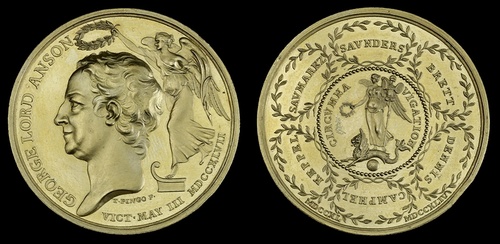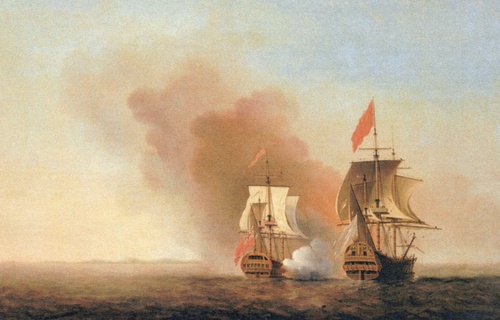Auction: 18003 - Orders, Decorations and Medals
Lot: 32
A scarce, important and well-preserved 1747 Anson Medal in Gold, struck for the defeat and capture of the French fleet at Cape Finisterre, 1747 and his previous circumnavigation of the globe: a piece of exceptional rarity, historical significance and visual appeal
1747 Lord Anson, 43mm, gold, plain edge, Obverse: Bust of Anson (left), hair short, no drapery, crowned by Winged Victory standing behind on the prow of a galley, Legend 'GEORGE LORD ANSON', below 'VICT . MAY III MDCCXLVII,' maker's mark 'T. PINGO F.' below bust, Reverse: Winged Victory, holding a wreath and a trophy, stands upon the back of a sea monster, over a small globe, the Legend 'CIRCVMNAVIGATION' around, all within a beaded circle, placed around are six laurel wreaths, bearing the inscriptions: 'KEPPEL, SAVMAREZ, SAVNDERS, BRETT, DENNIS, CAMPHEL', slight edge bruises on reverse at 5 o'clock and 7 o'clock, otherwise virtually as struck, with its original shagreen leather presentation case
Provenance:
Purchased La Riviere Collection, Bowers & Merena, New York, May 2001.
Christie's, June 1974.
Weight: 42.53 grams
George Anson, 1st Baron Anson (1697-1762), served as First Lord of the Admiralty during the Seven Years' War. His reforms laid the foundation for the modern British Navy, two of the most notable being the introduction of uniforms for commissioned officers, and the transfer of the Marines from Army to Navy authority. He invented the system of 'rating' ships according to their number of guns, and tightened discipline throughout the Navy with a revised version of the Articles of War.
Designed by Thomas Pingo of the Royal Mint, the Anson Medal was commissioned six years after Anson's death to commemorate his most celebrated achievements. The Obverse shows Anson being crowned by Winged Victory, above the date 3 May 1747. On that memorable day, Anson commanded the fleet that defeated Admiral de la Jonquière's Squadron off Cape Finisterre. Four ships of the line were captured, as well as two frigates and six merchantmen. The prize money amounted to £300,000, or £53 billion today.
The Reverse depicts Winged Victory standing on a sea monster above a globe, symbolising Anson's famous Circumnavigation of 1740-44. This feat happened largely by accident: appointed Commodore of the West Africa Squadron in November 1739, Anson was ordered to attack Spanish settlements along the Pacific coast of South America as part of the 'War of Jenkins' Ear'. He pursued the richly-laden Manila galleons that traded between Mexico and the Philippines, capturing the Nuestra Señora de Covadonga off Cape Espiritu Santo on 20 June 1743. This galleon contained 1,313,843 pieces of eight, making Anson an extremely wealthy man when he returned to England. Charts captured with the ship added many islands to British knowledge of the Pacific, including the Anson Archipelago.
The Reverse also features a circle of six laurel wreaths. They enclose the names of Anson's officers aboard H.M.S. Centurion, his flagship during the Circumnavigation: ''KEPPEL, SAVMAREZ, SAVNDERS, BRETT, DENNIS, CAMPBEL'. Augustus Keppel and John Campbel later became the finest naval commanders of their generation, owing much to the experience they gained on Anson's epic voyage. Scurvy took a terrible toll on Anson's crewmen, reducing his strength from 2,139 sailors in 1739 to 123 effectives when he returned to Portsmouth on 15 June 1744. This led to the widespread use of lime juice throughout the Navy as a cure for Scurvy, hence the nickname 'limeys'.
Though Anson Medals were struck in large numbers, Gold versions were produced only for Anson, the six aforementioned officers aboard H.M.S. Centurion, and the Captains of Anson's ships at the Battle of Cape Finisterre. Other examples in Gold are in the collection of The British Museum (1886,0105.1), the Royal Collection (RCIN 443232), and the National Maritime Museum, Greenwich (MEC1134).
Recommended reading:
Anson, G., A Voyage Round the World, in the Years MDCCXL, I, II, III, IV (London, 1748).
Gentleman's Magazine (London, 1786), p. 632.
Heaps, L., Log of the Centurion: Based on the original papers of Captain Philip Saumarez on board HMS Centurion, Lord Anson's flagship during his circumnavigation, 1740 - 1744 (London, 1973).
Subject to 20% VAT on Buyer’s Premium. For more information please view Terms and Conditions for Buyers.
Estimate
£10,000 to £12,000







